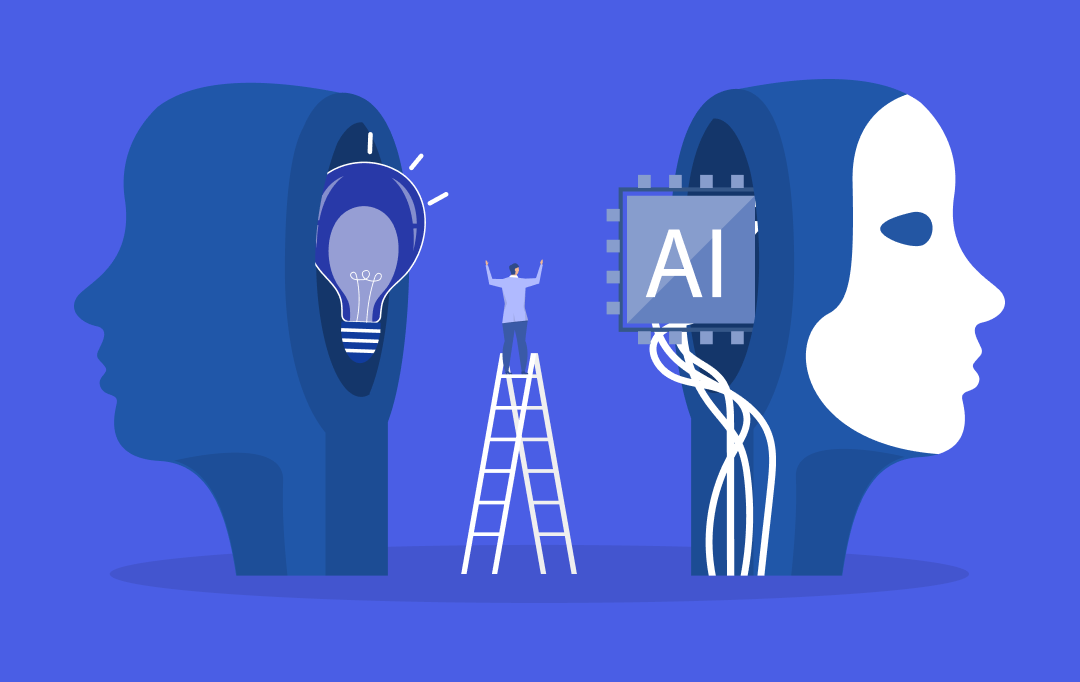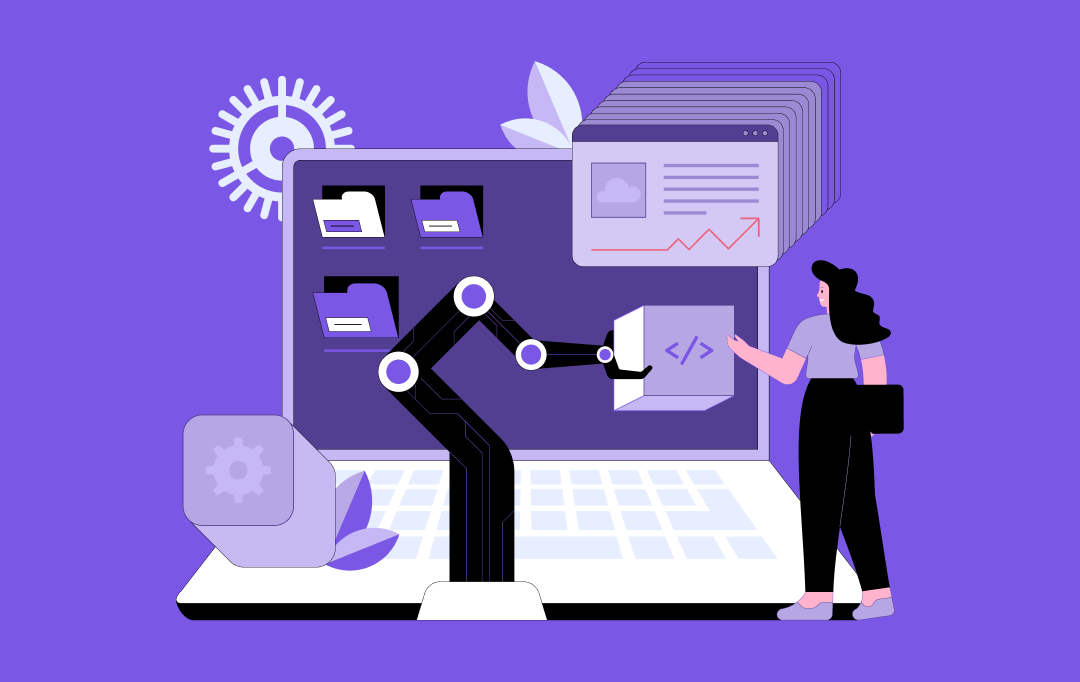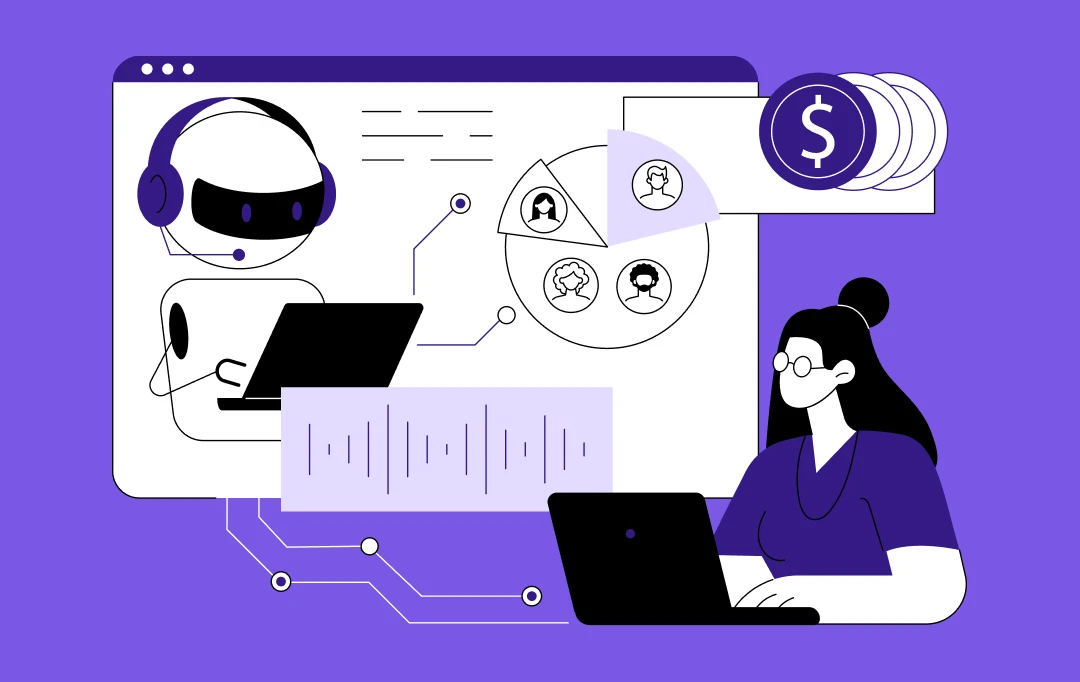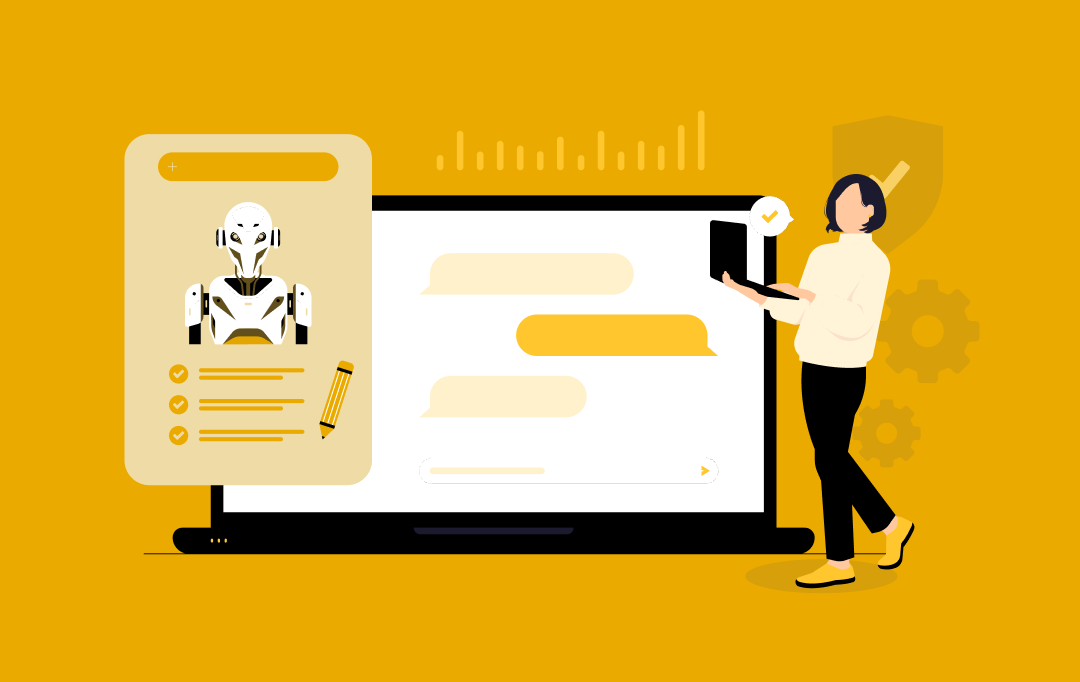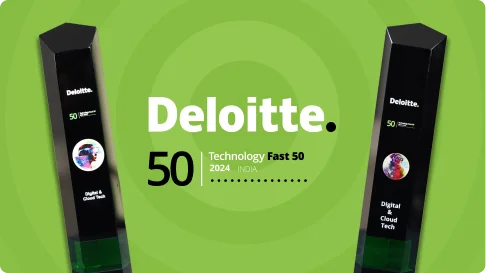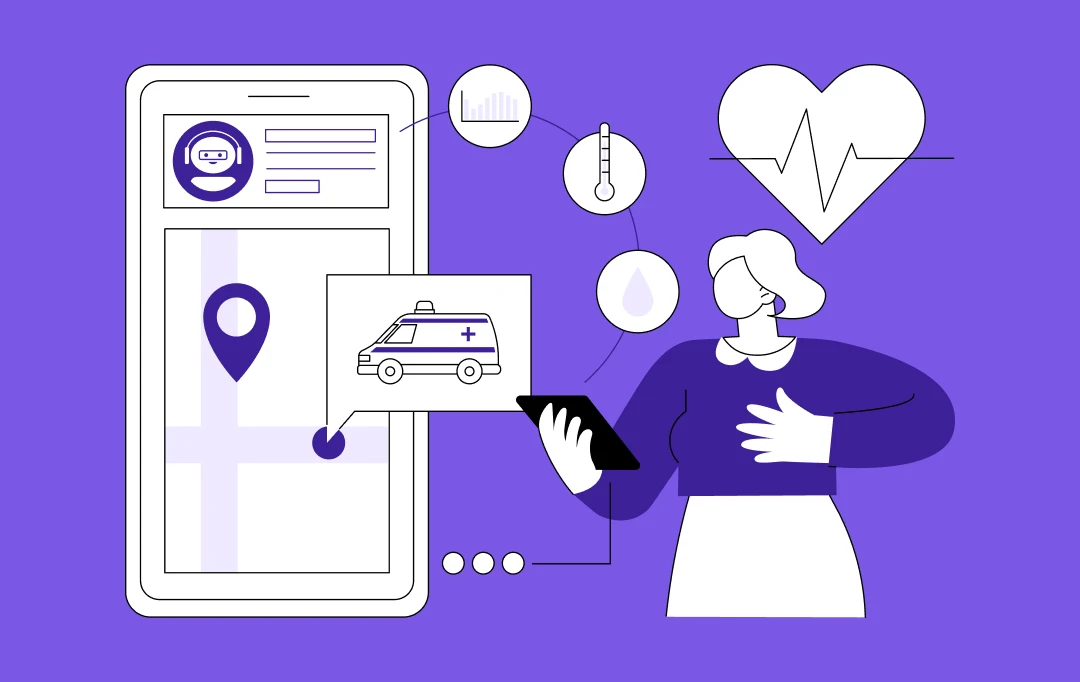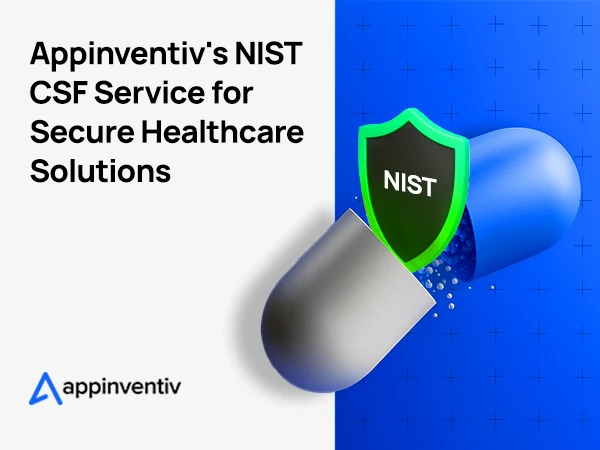- Machine Learning App Development Market Overview
- Explosive Market Growth
- Enterprise Adoption & Value
- Economic Impact & ROI
- Why Now Is the Time to Act
- What Does This Means for You?
- Understanding the Cost to Build a Machine Learning App
- Cost Analysis Based on App Development Stages
- Key Factors Influencing the Cost to Build a Machine Learning App
- 1. Feature Complexity
- 2. Data Volume and Quality
- 3. Machine Learning Algorithms and Model Complexity
- 4. Platform and Device Compatibility
- 5. AI and Cloud Infrastructure
- 6. Machine Learning App Development Framework
- 7. Data Security and Privacy Compliance
- 8. Over-the-Air (OTA) Model Updates
- 9. Real-Time Processing Capabilities
- 10. Cross-Industry Integrations
- Hidden Factors That Impact the Cost to Build a Machine Learning App
- 1. Data Collection and Labeling
- 2. Data Storage and Management
- 3. API and Third-Party Integration Costs
- 4. Hardware Costs for Model Training
- 5. Unexpected Model Retraining Needs
- 6. User Experience (UX) Optimization
- 7. Compliance Audits and Data Privacy Costs
- 8. Cross-Platform Synchronization
- 9. Vendor Lock-in Risks
- 10. Post-Launch Model Monitoring
- Types of Machine Learning Apps and Their Cost Ranges
- Cost Comparison: Custom ML Apps vs. Pre-Built/Off-the-Shelf Solutions
- Smart Ways to Optimize Machine Learning App Development Costs
- 1. Start with Core Features First
- 2. Use Modular Architecture
- 3. Leverage Open-Source AI Models and Toolkits
- 4. Automate Testing and Validation
- 5. Leverage Simulation Environments
- 6. Utilize Transfer Learning
- 7. Iterate Based on Real-World Data
- Must-Have Features in a Machine Learning App: Universal Essentials
- Core Universal Features for Machine Learning Apps
- Industry-Specific Feature Examples
- Step-by-Step Process to Build a Machine Learning App
- 2. Define Features and Requirements
- 3. Choose the Right Technology Stack
- 4. UI/UX Design
- 5. System Development
- 6. Testing and Quality Assurance
- 7. Launch
- 8. Feedback and Iteration
- 9. Maintenance and Updates
- Monetizing Machine Learning Apps: How Businesses Can Earn Money
- Why Appinventiv Is the Perfect Partner for Your Machine Learning App Development
- FAQs
Key takeaways:
- ML app costs range from $25,000 to $300,000+.
- Feature complexity is the biggest cost driver.
- Data quality impacts training time and accuracy.
- Hidden costs include APIs, storage, and retraining.
- Open-source tools help cut development costs.
We live in a world where speed, personalization, and real-time decisions are no longer luxuries—they are expected. Whether it’s recommending the next binge-worthy show, predicting customer churn, or automating complex business workflows, machine learning (ML) is the silent engine powering the experiences users love and businesses rely on.
For companies aiming to lead the curve, machine learning in mobile apps isn’t just a tech upgrade—it’s the new competitive edge. Businesses that fail to build machine learning apps risk falling behind, losing customers, and missing out on smarter, faster, and more scalable growth opportunities.
Across industries like healthcare, finance, eCommerce, and logistics, custom machine learning applications are transforming how products are built and how services are delivered. ML-powered software is reshaping industries by enabling apps that learn, adapt, and improve with every interaction—creating business value that goes beyond traditional systems.
But before you jump into developing apps with machine learning models, the big question is likely hovering in your mind:
“How much does it cost to build a machine learning app?”
To give you a quick snapshot—the machine learning app development cost typically ranges between $25,000 to $300,000 or more, depending on the app’s complexity, dataset size, ML model sophistication, and required infrastructure.
In this machine learning app development guide, we’ll unpack what drives these costs, where you can optimize, and how you can chart a realistic, successful path to building intelligent, future-ready apps. Whether you are a startup, an enterprise, or a team exploring enterprise-level machine learning app development, this guide will help you make smarter decisions.
Let’s get started.
Let’s break it down—fast, clear, and tailored to your vision.
Talk to our experts and get a custom quote today.
Machine Learning App Development Market Overview
The demand for machine learning in mobile apps and enterprise-grade systems is soaring—and the market figures tell the story:
Explosive Market Growth
- According to Statista, the global machine learning market is projected to grow from $105.45 billion in 2025 to $568.32 billion by 2031, representing a staggering CAGR of 32.41%.
- The market adoption is being driven by digital adoption, rising demand for AI solutions, and the need for advanced data processing and analysis.
Enterprise Adoption & Value
- A recent McKinsey survey notes that 71% of leading enterprises use generative AI (ML-based) in at least one core function—spanning marketing, operations, and software development
- However, only 1% of companies have fully scaled AI, signaling a massive untapped opportunity.
Economic Impact & ROI
- McKinsey estimates that generative AI alone could deliver $2.6–4.4 trillion annually in value, especially across customer operations, R&D, and software engineering
Why Now Is the Time to Act
- 92% of companies plan to increase AI investment in the next three years, indicating a near-universal recognition of ML’s transformative potential.
- The competitive gap between early adopters and late movers is widening fast—those who delay risk being left behind. With infrastructure, tools, and talent more accessible than ever, there’s no better time to start building intelligent, ML-powered apps.
What Does This Means for You?
| Insight | Implication |
|---|---|
| Market giants are investing heavily in ML apps | Competitive differentiation through enterprise-level machine learning app development is crucial. |
| Businesses see real ROI | Higher revenues and cost optimization make custom machine learning applications a strategic must. |
| Most companies haven’t scaled yet | This is your window to develop machine learning apps before the space is saturated. |
| Mobile environments are key battlegrounds | Embracing machine learning in Android and iOS is critical to user engagement and retention. |
Understanding the Cost to Build a Machine Learning App
Building a machine learning app requires a thoughtful investment in time, expertise, and the right technological stack. As mentioned earlier, the cost to build a machine learning app typically ranges from $25,000 to $300,000 or more, depending on factors like app complexity, model sophistication, and infrastructure requirements. The cost can escalate as businesses move from simple predictive models to enterprise-level machine learning app development involving real-time learning, complex data pipelines, and multi-layered security.
When estimating your potential investment, a basic formula can guide you:
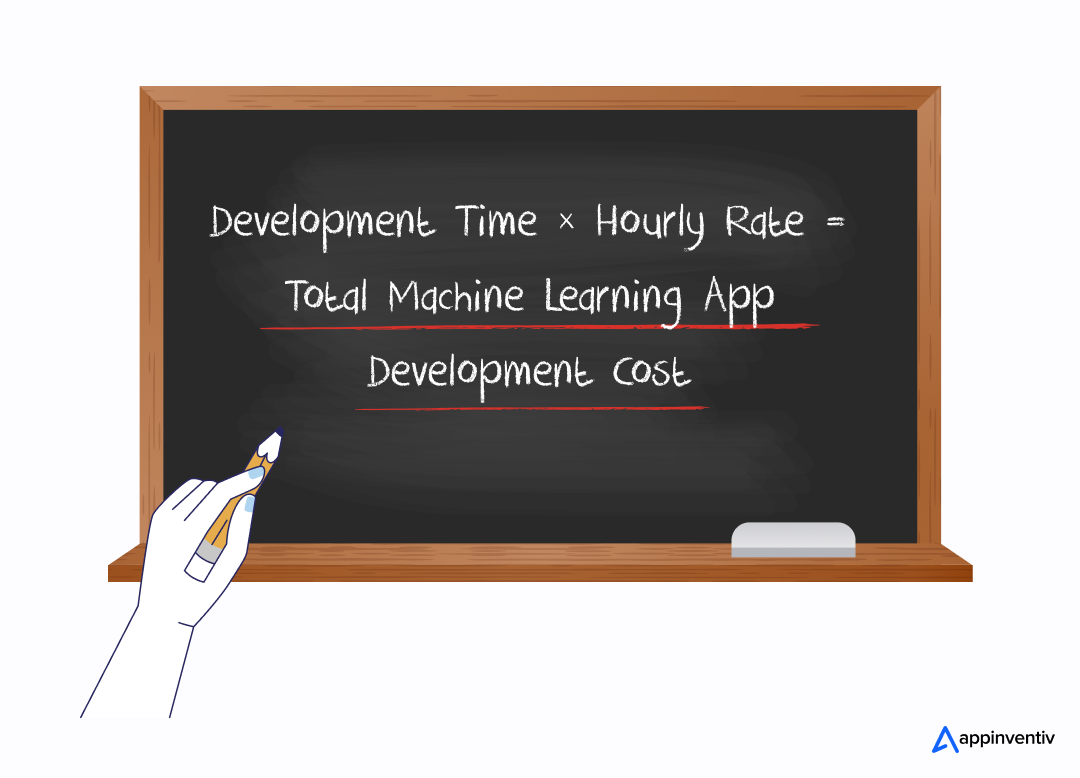
This formula helps project the budget based on how many hours your development team will invest and the average hourly rate of ML developers.
Cost Analysis Based on App Development Stages
Let’s break down the cost to develop a machine learning app across key development stages:
| Development Stage | Duration | Estimated Cost |
|---|---|---|
| Research & Planning | 2–4 weeks | $5,000 – $15,000 |
| Design & Architecture | 1–2 months | $10,000 – $25,000 |
| Core Development | 4–8 months | $50,000 – $200,000 |
| Testing & Validation | 2–3 months | $20,000 – $50,000 |
| Launch & Deployment | 1 month | $5,000 – $15,000 |
| Maintenance & Updates | Ongoing | $2,000 – $10,000/month |
To understand in detail the costs associated with the ML app development, check out our blog on- Estimating the Time, Cost, and Deliverables of an ML App Project.
Key Factors Influencing the Cost to Build a Machine Learning App
The cost to build a machine learning app is shaped by multiple variables that go beyond just development time. Each factor adds unique layers of complexity, effort, and budget considerations, especially when you aim to build custom machine learning applications with scalable, intelligent features.
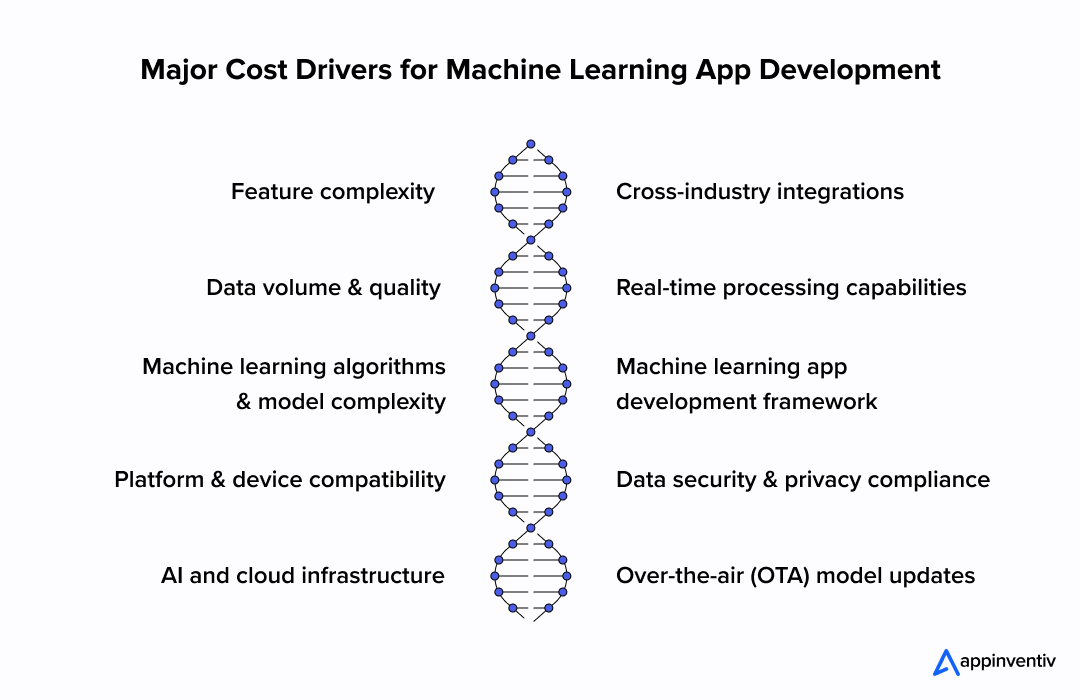
1. Feature Complexity
The more advanced the features, the higher the cost. Basic apps with simple prediction models are cheaper to build, but apps that require deep learning for mobile applications, real-time personalization, image recognition, or complex decision-making will significantly raise both development time and cost.
2. Data Volume and Quality
The quality and size of your training dataset directly impact the machine learning app development cost. More extensive datasets require more storage, longer model training times, and additional data cleaning, driving up expenses.
3. Machine Learning Algorithms and Model Complexity
Using advanced machine learning algorithms for app development such as neural networks or reinforcement learning requires specialized expertise, larger computing power, and extensive testing, all contributing to higher costs.
4. Platform and Device Compatibility
Whether you’re building machine learning in Android, iOS, or web-based apps, adapting the app across multiple platforms and devices increases development efforts. Compatibility testing can add significant costs, especially in enterprise-level machine learning app development.
5. AI and Cloud Infrastructure
High-performance computing resources, GPU support, and cloud storage are required to manage data pipelines and run real-time models. The infrastructure for developing apps with machine learning models and deploying cloud-based predictions can heavily influence your budget.
6. Machine Learning App Development Framework
Choosing the right machine learning app development framework (like TensorFlow, PyTorch, or Apache MXNet) affects costs. Some frameworks are more resource-efficient, while others may demand more advanced engineering.
7. Data Security and Privacy Compliance
When handling sensitive data, especially in machine learning in mobile apps, the app must comply with security standards like GDPR. Implementing strong encryption, access controls, and privacy protocols increases the cost to build a machine learning app.
8. Over-the-Air (OTA) Model Updates
Integrating OTA update functionality ensures your ML models can evolve without forcing users to reinstall apps. This requires additional cloud setup and continuous monitoring, which adds to the machine learning app development cost.
9. Real-Time Processing Capabilities
If your app demands real-time decision-making (like fraud detection or instant recommendations), you’ll need edge computing and highly optimized code. Building custom machine learning applications with real-time processing raises engineering complexity and cost.
10. Cross-Industry Integrations
When your ML app must integrate with third-party systems like CRMs, IoT platforms, or payment gateways, the machine learning app development process becomes more complicated and resource-intensive.
Hidden Factors That Impact the Cost to Build a Machine Learning App
While most companies focus on visible cost drivers like development time and feature sets, several hidden factors can silently inflate the machine learning app development cost. Understanding these factors early can help you plan your budget more effectively and avoid costly surprises.
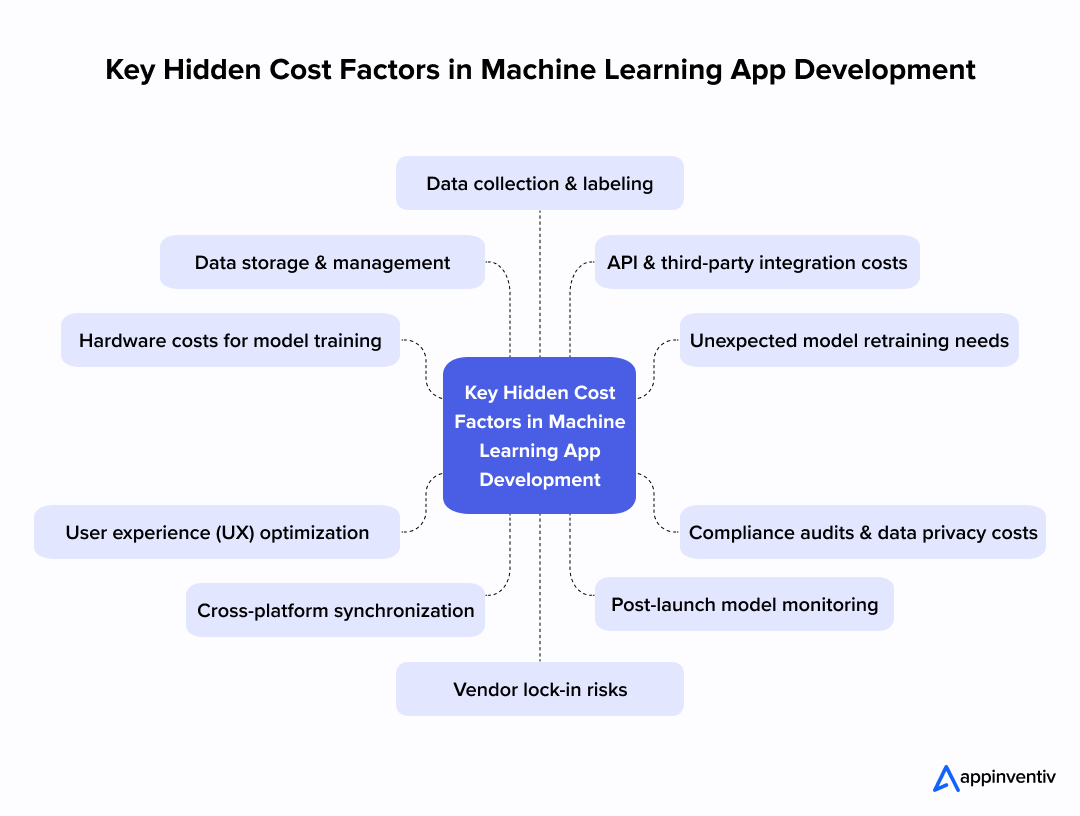
1. Data Collection and Labeling
For custom machine learning applications, raw data is not enough. Data must be cleaned, labeled, and categorized, which often requires manual effort or specialized data labeling services. This step is essential but can significantly increase the cost to build a machine learning app.
2. Data Storage and Management
As machine learning in mobile apps often involves handling large datasets, cloud storage and database management become ongoing expenses. Hidden costs can arise from scaling your storage, backup, and real-time access needs, especially when using cloud platforms like AWS or Google Cloud or Azure.
3. API and Third-Party Integration Costs
Many machine learning app features require external APIs for tasks like sentiment analysis, location tracking, or payment processing. These third-party services often charge per API call, adding hidden recurring costs to the project.
4. Hardware Costs for Model Training
Building intelligent apps with machine learning algorithms for app development may require access to GPU-based cloud servers or on-premises hardware, especially for deep learning models. These costs are easy to overlook during initial budgeting but can quickly escalate.
5. Unexpected Model Retraining Needs
Your ML models can drift over time as real-world data changes. The machine learning app development process may need to include frequent retraining cycles, which demand additional development hours, new datasets, and computing resources.
6. User Experience (UX) Optimization
For machine learning mobile app ideas to succeed, the app must provide a smooth, intuitive user interface. The UX optimization phase often demands extra design and testing cycles, especially when integrating complex ML features that need to feel natural to the end-user.
7. Compliance Audits and Data Privacy Costs
Apps handling personal data, particularly in machine learning in Android and iOS platforms, must comply with global data privacy regulations like GDPR or CCPA. Hidden costs may emerge from legal consultations, security audits, and implementing privacy features.
8. Cross-Platform Synchronization
When developing apps with machine learning models across both web and mobile platforms, ensuring seamless data synchronization and user experience can involve additional backend complexity and development time.
9. Vendor Lock-in Risks
Choosing specific ML platforms, cloud providers, or machine learning app development frameworks can lead to vendor lock-in, forcing you to stick with costly services long-term or pay high migration fees if you decide to switch.
10. Post-Launch Model Monitoring
After deployment, machine learning app development costs can continue to rise due to the need for ongoing model performance tracking, bias detection, and maintenance of the prediction pipelines to keep the app functioning accurately.
Types of Machine Learning Apps and Their Cost Ranges
Not all ML apps are created equal—some are lightweight and task-specific, while others require enterprise-grade infrastructure and deep learning capabilities. Below is a breakdown of common ML app types and their estimated development cost ranges based on feature complexity, data requirements, and platform compatibility.
| Type of ML App | Common Use Cases | ML Techniques Used | Estimated Cost Range |
|---|---|---|---|
| Recommendation Engines | Product suggestions, content curation (eCommerce, OTT) | Collaborative Filtering, Matrix Factorization | $25,000 – $80,000 |
| Predictive Analytics Tools | Sales forecasts, churn prediction, demand forecasting | Regression, Time-Series Models | $30,000 – $90,000 |
| Chatbots & Virtual Assistants | Customer support, onboarding bots, virtual HR assistants | NLP, Transformers (e.g., BERT, GPT) | $40,000 – $120,000 |
| Computer Vision Apps | Facial recognition, medical imaging, object detection | CNNs, Image Segmentation | $60,000 – $150,000 |
| Voice & Speech Recognition Apps | Voice assistants, real-time transcription, voice commands | RNNs, LSTMs, Transformer-based ASR | $50,000 – $130,000 |
| Fraud Detection Systems | Financial fraud detection, cybersecurity alerts | Anomaly Detection, Random Forest, SVM | $70,000 – $180,000 |
| Healthcare Diagnostic Apps | Symptom checkers, diagnostic imaging, treatment recommendation | CNNs, Ensemble Learning | $80,000 – $250,000+ |
| Personal Finance & Budgeting Apps | Spending insights, credit analysis, smart saving recommendations | Rule-based + Supervised ML | $30,000 – $100,000 |
| Smart Marketplaces | Job-matching platforms, real estate finders, dating apps | Classification, Recommender Systems | $50,000 – $150,000 |
| Predictive Maintenance Apps | Equipment failure prediction, manufacturing ops optimization | LSTM, ARIMA, Sensor Data Analysis | $90,000 – $220,000+ |
| Generative AI Apps | Text/image generation, design suggestions, copywriting tools | Large Language Models, GANs, Diffusion | $120,000 – $300,000+ |
Cost Comparison: Custom ML Apps vs. Pre-Built/Off-the-Shelf Solutions
While off-the-shelf machine learning tools and APIs may seem appealing for their speed and simplicity, they’re rarely built to scale with your business—or adapt to its evolving needs. On the other hand, custom ML app development offers full control, superior performance, and long-term ROI that plug-and-play solutions simply can’t match.
| Factor | Custom ML App Development (Recommended) | Pre-Built/Off-the-Shelf ML Tools |
|---|---|---|
| Initial Cost | $25,000 – $300,000+ (One-time or phased investment) | $0 – $10,000+ (but recurring) |
| Flexibility & Customization | Full control over models, features, data pipelines | Limited to fixed capabilities of the API |
| Scalability | Built to scale with your product and user base | May incur higher usage fees or hit performance limits |
| Data Privacy & Ownership | 100% ownership, with secure, localized data control | Data processed/stored by third-party providers |
| Integration Capability | Seamless alignment with your workflows, systems, and KPIs | Limited integration flexibility beyond basic use cases |
| Long-Term ROI | Higher upfront but lower TCO and better strategic value | Quick start, but costlier and rigid in the long run |
| Model Retraining & Updates | Custom retraining based on real-world data | Dependent on third-party updates and model generalization |
| Best For | Enterprises, scale-ups, and IP-driven products | MVPs, low-usage apps, or quick experiments |
While pre-built ML APIs are useful for simple tasks, they quickly hit a ceiling. If your product demands unique logic, brand-specific experiences, or scalable intelligence, custom ML development isn’t just better—it’s essential.
Smart Ways to Optimize Machine Learning App Development Costs
Building intelligent apps doesn’t always require an unlimited budget. With the right strategies, businesses can build machine learning apps efficiently while managing costs.
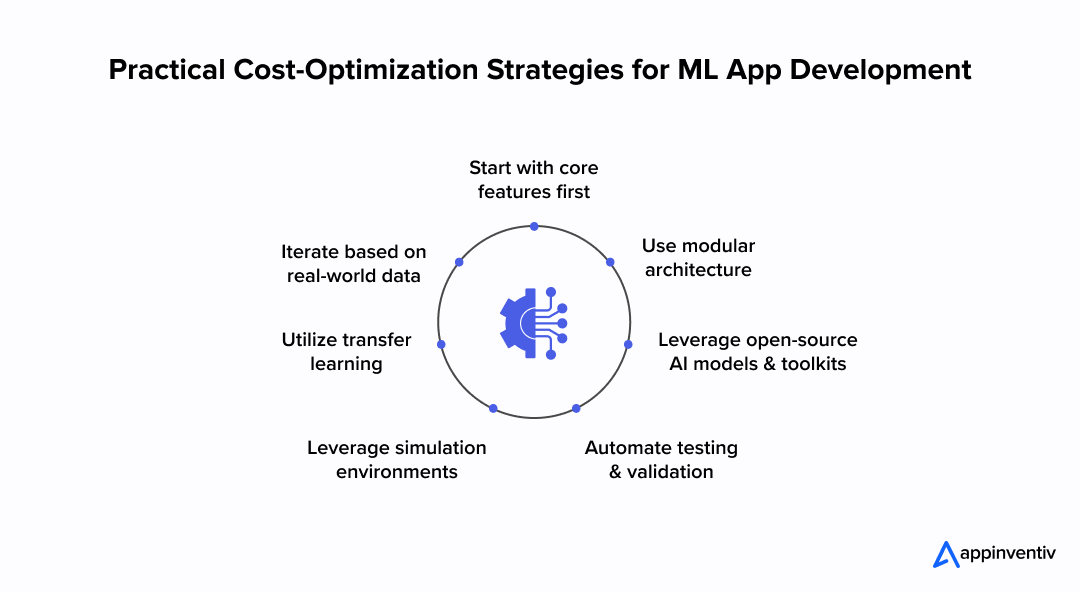
1. Start with Core Features First
Begin by developing a minimum viable product (MVP) that focuses on essential features. Launching with basic prediction models or machine learning mobile app ideas allows you to enter the market quickly, collect user data, and improve intelligently over time.
2. Use Modular Architecture
Design your app using modular components so that you can build, test, and deploy individual features like user segmentation or recommendation engines separately. This lowers the cost to develop a machine learning app by avoiding complete system overhauls for future updates.
3. Leverage Open-Source AI Models and Toolkits
Adopt open-source AI machine learning applications and pre-built ML models to cut development time and engineering costs. According to McKinsey, 60% of companies already deploy open-source models to speed up production and lower total costs (McKinsey Report).
4. Automate Testing and Validation
Use automated testing tools to validate model performance and UI functionality across devices. Automated testing minimizes manual effort and reduces time-to-market in the machine learning app development process. Thus, helping in optimizing the overall cost to build a machine learning app.
5. Leverage Simulation Environments
Instead of depending solely on real-world user data, you can use simulated datasets to train your ML models. This can significantly cut data collection costs during the early development phase.
6. Utilize Transfer Learning
Transfer learning allows you to use pre-trained models for similar tasks, reducing the time and computational resources required for training from scratch. This is particularly valuable when building machine learning apps in Android or resource-constrained mobile environments.
7. Iterate Based on Real-World Data
Once deployed, continuously collect app usage data to optimize model performance and user experience. This helps prioritize which features to improve or remove, avoiding unnecessary investments.
Must-Have Features in a Machine Learning App: Universal Essentials
Not all machine learning apps are built the same. A healthcare app, a finance app, and an eCommerce app may each rely on different custom machine learning applications to solve unique problems. However, some features are essential to the success of any machine learning app, no matter the industry, platform, or use case.
Whether you are building intelligent apps with machine learning for Android, iOS, or enterprise systems, these universal features ensure your app is scalable, reliable, and ready to deliver real value.
Let’s explore the must-have features in machine learning apps that every business should consider.
Core Universal Features for Machine Learning Apps
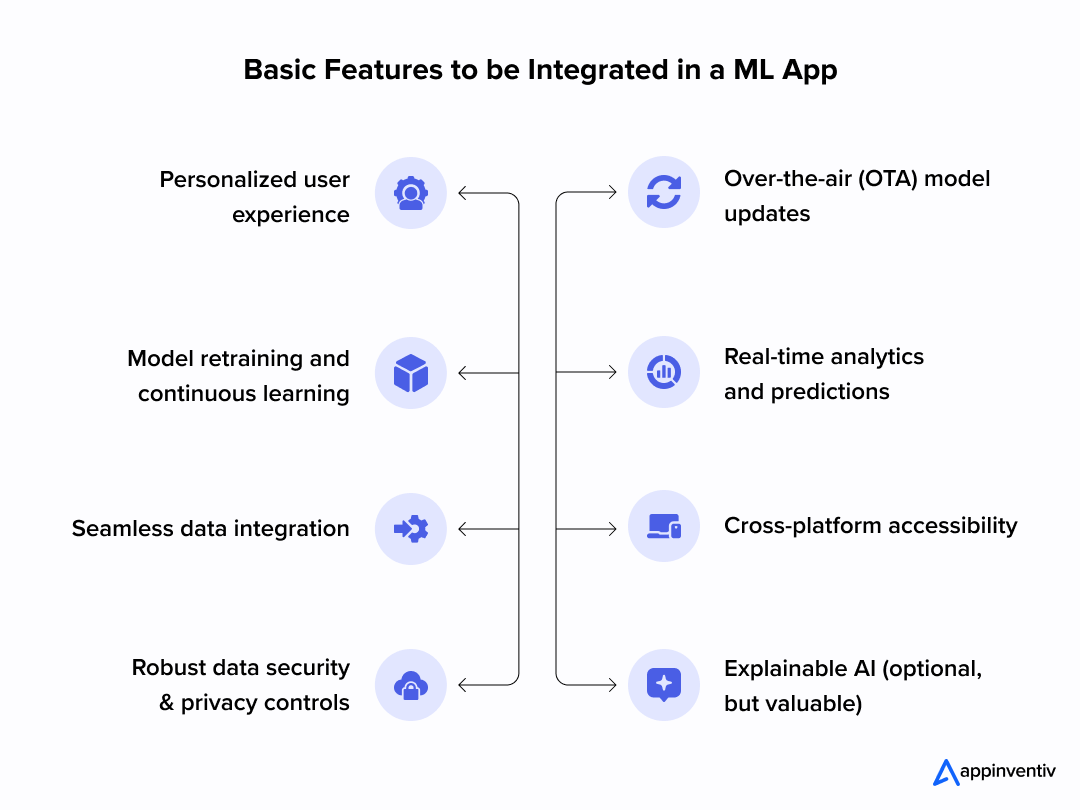
- Personalized User Experience
One of the top benefits of ML in apps is real-time personalization. Whether it’s product recommendations, content suggestions, or dynamic interfaces, ML apps should offer customized experiences based on user behavior and preferences. This feature boosts engagement and makes machine learning in mobile apps feel intuitive and highly relevant.
- Real-Time Analytics and Predictions
A must-have in machine learning app features is the ability to provide real-time predictions, alerts, and insights. From fraud detection in fintech apps to instant content recommendations in media platforms, users now expect apps to process and respond to their inputs instantly.
- Model Retraining and Continuous Learning
Modern apps must support developing apps with machine learning models that can continuously learn and improve. Your app should allow regular model retraining based on incoming user data to ensure that predictions stay accurate over time.
- Seamless Data Integration
A successful machine learning app development process requires integrating multiple data sources, whether from IoT devices, CRMs, or social platforms. Seamless data pipelines ensure that your ML models stay relevant and that your app delivers accurate, real-time results.
- Robust Data Security and Privacy Controls
Security is a critical part of machine learning in Android and iOS apps, especially when handling personal data. Features like encrypted storage, secure APIs, user consent management, and GDPR/CCPA compliance are mandatory to protect user information and maintain trust.
- Over-the-Air (OTA) Model Updates
Custom machine learning applications should allow for OTA model updates so businesses can refine algorithms and release performance improvements without needing manual app updates. This feature ensures scalability and long-term success.
- Cross-Platform Accessibility
Supporting machine learning in mobile apps and web platforms ensures a unified experience across devices. Cross-platform accessibility allows users to switch seamlessly between environments while the app delivers consistently smart, ML-driven outcomes.
- Explainable AI (Optional, but Valuable)
As machine learning becomes mainstream, building intelligent apps with machine learning should ideally include explainability features. Users should understand why a recommendation or decision was made, which improves transparency and builds trust.
[Also Read: How Explainable AI can Unlock Accountable and Ethical Development of Artificial Intelligence]
Industry-Specific Feature Examples
While universal features apply to all apps, machine learning mobile app ideas and specific industries will demand tailored functionalities. Here are a few examples:
| Industry | Machine Learning Feature Example |
|---|---|
| Healthcare | Predictive diagnostics, patient-specific treatment suggestions |
| eCommerce | Dynamic pricing, smart product recommendations |
| Finance | Fraud detection, real-time credit scoring |
| Logistics | Route optimization, demand forecasting |
| Entertainment | Personalized content feeds, user behavior analytics |
| Social Media | Sentiment analysis, automated moderation |
Step-by-Step Process to Build a Machine Learning App
Building a successful machine learning app requires more than just coding—it demands a carefully planned, step-by-step approach. Below is a complete guide to help you navigate each phase of the machine learning app development process efficiently.
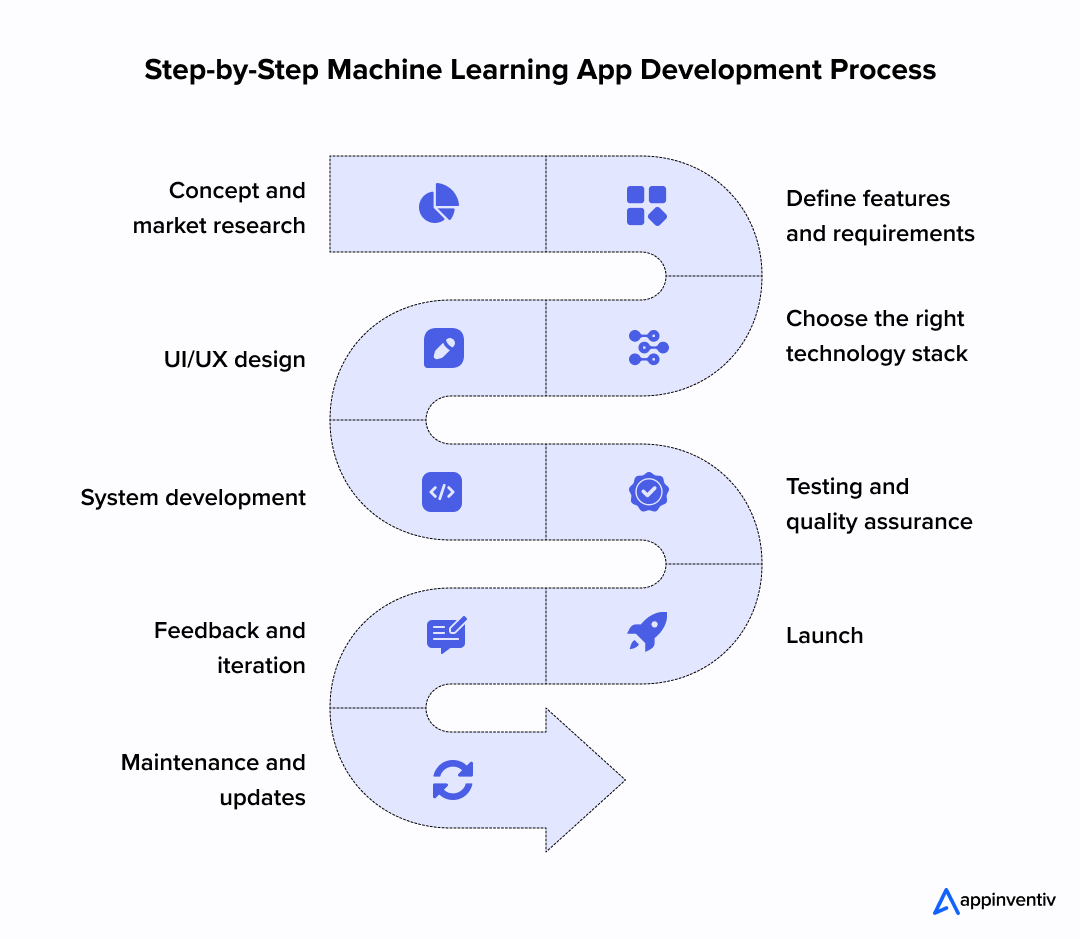 1. Concept and Market Research
1. Concept and Market Research
Start by clearly defining the purpose of your machine learning app and identifying the target audience. Explore the current market to uncover gaps, user pain points, and the most relevant machine learning mobile app ideas that can stand out. Study industry-specific competitors to understand how they are leveraging AI machine learning applications. Detailed market research helps you choose the right direction and predict what features users expect from intelligent apps.
2. Define Features and Requirements
List out the essential machine learning app features you need—like real-time predictions, recommendation engines, image recognition, or speech processing. This is where you decide whether to incorporate machine learning in Android, iOS, or cross-platform environments. You must also specify model requirements, data sources, and the expected accuracy levels to ensure your custom machine learning application meets real-world performance standards.
3. Choose the Right Technology Stack
Selecting the appropriate machine learning app development framework is critical for long-term success. Depending on your app’s complexity, you might choose TensorFlow, PyTorch, or Apache MXNet, which are popular for developing apps with machine learning models. Make sure your tech stack supports cloud integration, real-time processing, scalability, and over-the-air (OTA) model updates to future-proof your app and keep operational costs manageable.
4. UI/UX Design
Designing a seamless and user-friendly interface is essential for machine learning in mobile apps. The goal is to make complex ML features feel simple and intuitive to the end-user. The UI should visually display smart suggestions, predictions, or alerts without overwhelming the user. During this phase, you must also ensure accessibility, responsiveness, and that the app aligns with the benefits of ML in apps by delivering smoother user journeys.
5. System Development
The core machine learning app development process begins here, where your team codes the backend, integrates machine learning models, and sets up data pipelines. This is where you build features like automated personalization, real-time object recognition, or fraud detection, depending on your app’s focus. For enterprise-level machine learning app development, additional layers like API integrations and security protocols are added to support complex workflows.
6. Testing and Quality Assurance
Testing is one of the most critical phases in building intelligent apps with machine learning. It involves validating your algorithms using real-world and simulated datasets to ensure predictions are accurate and the app works across multiple devices. Quality assurance also checks for data security, system speed, and how well the app handles edge cases, especially when you develop machine learning apps in Android where devices vary greatly in hardware capabilities.
7. Launch
Once your machine learning app passes quality checks, it’s ready for a limited or staged launch. This could mean rolling it out to select regions, test markets, or beta users first to collect initial feedback. During this phase, it’s crucial to monitor how the app interacts with users and how well it handles real-time data. Preparing documentation and onboarding resources is also essential to ensure successful user adoption.
8. Feedback and Iteration
After the initial launch, you must continuously gather user feedback and system performance data. This phase helps you refine your machine learning algorithms for app development based on real-world conditions and user behavior. By iterating based on this data, you can enhance the app’s accuracy, improve user experience, and deliver better results aligned with the future of machine learning in apps.
9. Maintenance and Updates
Ongoing maintenance is required to update models, improve security, fix bugs, and adapt to new user needs. Using over-the-air updates, you can deploy new features and retrained models efficiently without disrupting the user experience. Regular maintenance also helps you scale your custom machine learning applications as your user base grows.
Monetizing Machine Learning Apps: How Businesses Can Earn Money
Machine learning apps are not just powerful—they can be highly profitable when monetized strategically. Whether you are building custom machine learning applications or exploring machine learning mobile app ideas, the right revenue model can help you unlock scalable, recurring income streams.
Below are some of the most effective ways businesses can generate revenue through machine learning in mobile apps and enterprise platforms.
| Monetization Model | Description | Example Use Cases | Benefits |
|---|---|---|---|
| Subscription-Based Model | Users pay monthly or annually to access machine learning app features like advanced analytics, personalization, or premium content. | Fitness apps with adaptive training, financial apps with smart forecasting | Predictable, recurring revenue stream |
| Freemium with Premium ML Features | Basic features are free, but custom machine learning applications offer paid upgrades like intelligent recommendations or real-time analytics. | Music apps with personalized playlists, eCommerce apps with smart shopping assistants | Wide user base with strong upsell potential |
| Pay-Per-Use Pricing | Users pay based on app usage, such as per prediction, analysis, or data processed by machine learning algorithms for app development. | Logistics route optimization, cloud-based AI services | Scalable with direct value alignment |
| Advertising and Targeted Marketing | Monetize through smart, ML-driven ads that adapt based on user preferences and behavior. | Social media apps, free news apps with personalized content | High engagement and increased ad revenue |
| Licensing the ML Model or API | Offer your machine learning app development framework or trained models as licensed APIs to other businesses. | Fraud detection APIs, recommendation engine APIs | Strong B2B revenue stream |
| Data-as-a-Service (DaaS) | Sell anonymized data insights collected from machine learning in Android and iOS apps, if compliant with privacy laws. | Retail footfall analysis, user behavior trends | Additional income with proper compliance |
| In-App Purchases Powered by ML | Use machine learning in mobile apps to recommend personalized products or services that can be purchased directly in-app. | Gaming apps, shopping apps | Increased cart value and higher conversions |
| AI-Driven Performance Boosters | Offer premium ML-powered add-ons like faster processing, more storage, or advanced real-time features. | Video editing apps, large-scale B2B dashboards | Tiered revenue models and scalable upselling |
Why Appinventiv Is the Perfect Partner for Your Machine Learning App Development
We hope this machine learning app development guide has helped you understand the complete landscape and cost, including what drives those costs and how to monetize your solution effectively. Now that you’re considering development, choosing a trusted partner is critical—not just to build your app, but to build it right.
At Appinventiv, we specialize in delivering custom machine learning applications that aren’t just functional—they’re transformative. Our cross-functional teams of data scientists, ML engineers, UI/UX designers, and cloud experts collaborate to craft scalable, intelligent software that drives real-world results.
Whether you’re building intelligent apps with machine learning for Android, iOS, or cross-platform systems, we ensure your product can learn, adapt, and improve with every user interaction. From model training and real-time processing to seamless OTA model updates and data privacy compliance, our machine learning consulting services bring full-stack expertise to every project.
For instance, we recently developed an ML-powered employment platform—JobGet—that has revolutionized blue-collar hiring by providing smart, real-time job matches, resulting in over 2 million downloads and $52 million in Series B funding.
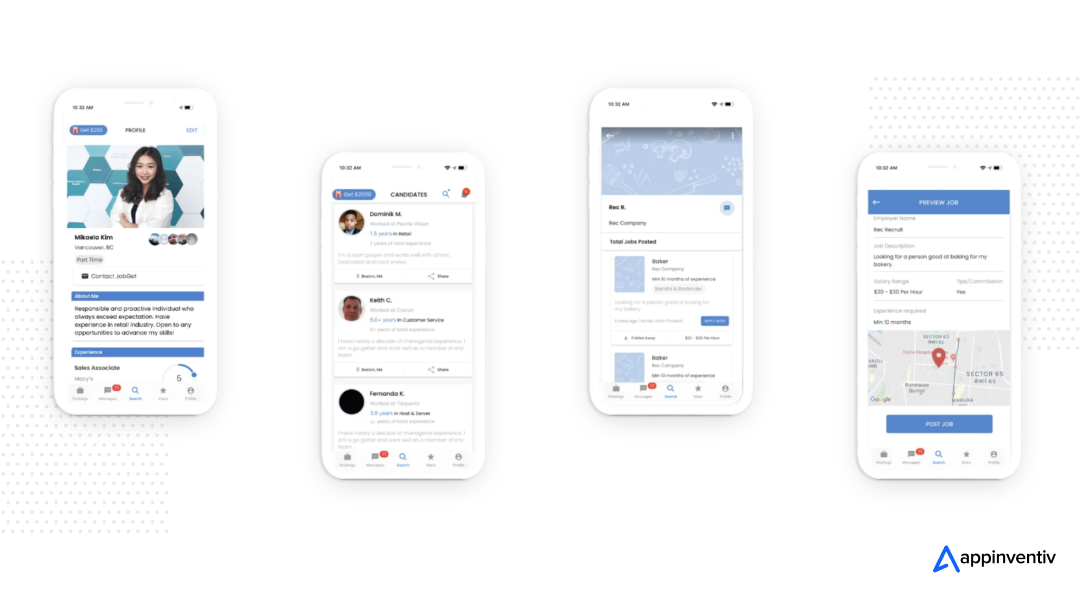
We also developed MUDRA, an AI-driven budget assistant that uses a chatbot interface and predictive analytics to help users track spending habits—now successfully launched across 12+ countries.
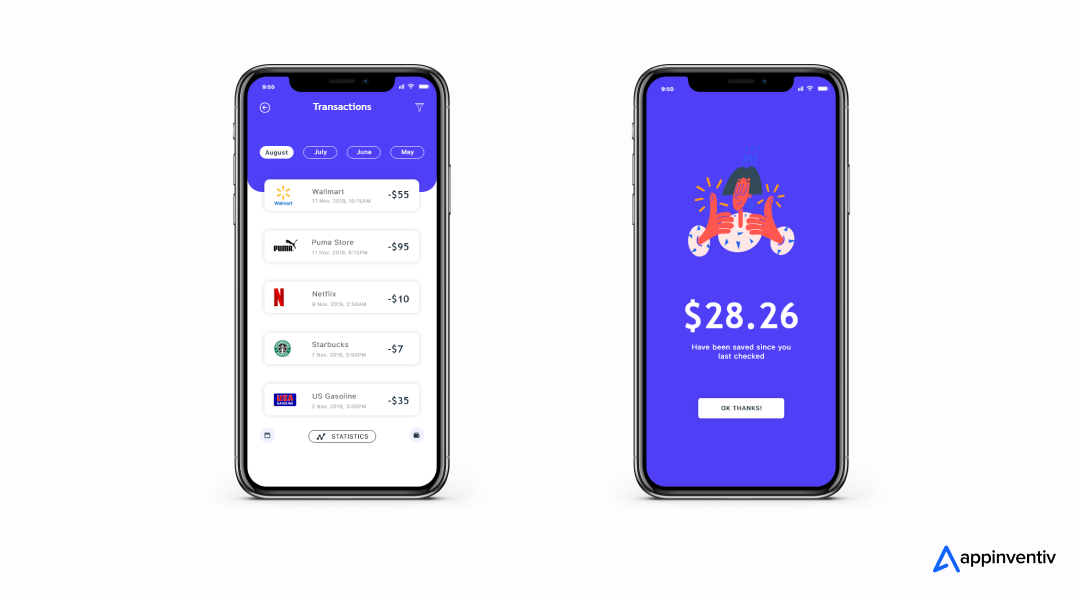
These success stories reflect our ability to build machine learning in mobile apps that don’t just work—they lead markets. Whether you’re building for Android, iOS, or enterprise, we help you develop apps with machine learning models that learn, adapt, and drive real impact.
If you’re ready to unlock the power of machine learning in mobile apps and deliver AI-powered value to your users, get in touch with us to make it happen.
FAQs
Q. What are the key steps in developing a machine learning app?
A. Developing a machine learning app involves a structured, multi-phase approach to ensure accuracy, scalability, and user value.
- Step 1: Define the problem and use case
- Step 2: Collect and prepare the dataset
- Step 3: Choose the right machine learning model
- Step 4: Train and validate the model
- Step 5: Integrate the model into the app backend
- Step 6: Design user-friendly UI/UX
- Step 7: Test the full system and optimize performance
- Step 8: Deploy the app and monitor in real time
- Step 9: Update models regularly via retraining
Q. What factors influence the cost of building a machine learning app with Appinventiv?
A. The cost of building a machine learning app varies depending on the complexity of features, the volume of data, and the app’s requirements. At Appinventiv, we provide a transparent cost breakdown, ensuring you understand each aspect of your investment—from feature development to cloud infrastructure. We’ll work with you to optimize the budget while delivering a solution tailored to your needs.
Q. How can machine learning be integrated into a mobile app?
A. Integrating machine learning into a mobile app requires both backend intelligence and frontend adaptability. First, the ML model is trained using relevant data and exported in a mobile-friendly format (e.g., Core ML for iOS or TensorFlow Lite for Android). This model is then integrated into the app using SDKs or APIs. In some cases, predictions happen on-device (edge ML), while others use cloud-based inference for complex tasks. The app interface is designed to trigger the model intelligently—such as recommending content, detecting images, or processing voice commands—creating a seamless machine learning in mobile apps experience.
Q. How will machine learning help me increase ROI on my mobile app?
A. Machine learning enables smarter, data-driven decisions that improve customer experiences and operational efficiencies, directly impacting your bottom line. Whether you’re automating processes or personalizing content, ML-driven features can boost engagement, reduce churn, and optimize revenue streams.
Q. What tools and platforms can I use for machine learning app development?
A. Choosing the right tools is essential for efficient machine learning app development.
- TensorFlow / TensorFlow Lite – Ideal for Android and cross-platform apps
- Core ML – Optimized for iOS-based machine learning in mobile apps
- PyTorch – Popular for R&D and prototyping ML models
- Firebase ML Kit – Google’s ML SDK for on-device mobile use
- AWS SageMaker / Google AI Platform / Azure ML – For cloud-based ML pipelines
- Python & Jupyter Notebooks – Core tools for ML algorithm development
Q. What are the top machine learning models for app development?
A. The best models depend on the app’s use case, but these are among the most widely used in developing apps with machine learning models:
- Linear Regression / Logistic Regression – For predictions and classifications
- Decision Trees / Random Forests – For structured data and rule-based logic
- K-Means Clustering – For segmentation and unsupervised learning
- Convolutional Neural Networks (CNNs) – For image recognition and vision-based apps
- Recurrent Neural Networks (RNNs) / LSTMs – For time-series and sequence-based data
- Transformer Models / BERT / GPT – For NLP, chatbots, and text generation
Q. How much does it cost to build a machine learning app?
A. The cost to build a machine learning app typically ranges from $25,000 to $300,000 or more, depending on factors like app complexity, the volume and quality of training data, model sophistication, platform compatibility, and infrastructure. Apps with basic prediction models cost less, while those involving deep learning, real-time analytics, or multi-platform support require more resources and a higher budget. Planning for hidden costs like API usage, cloud storage, retraining, and data security is also essential.
Q. What is the average time frame to develop a machine learning app?
A. On average, it takes 4 to 12+ months to develop a machine learning app, depending on the project scope and functionality. The process includes stages like research, UI/UX design, model development, backend integration, testing, and deployment. Basic apps can be built in 4–6 months, while complex, enterprise-level ML apps may take up to a year or more due to additional tasks like continuous learning setup, cross-platform optimization, and compliance testing.


- In just 2 mins you will get a response
- Your idea is 100% protected by our Non Disclosure Agreement.

15 Use Cases on How AI Is Transforming Virtual Reality: The Future of Immersive Experiences
Key takeaways: Market Growth: The AI in VR market is projected to surge from USD 21.2 billion in 2023 to USD 198.5 billion by 2033, with a CAGR of 25.0%. Transformative Applications: AI-driven VR reshapes industries with 15 use cases, including immersive training, personalized retail, and medical simulations. Business Advantages: AI enhances VR with personalization,…
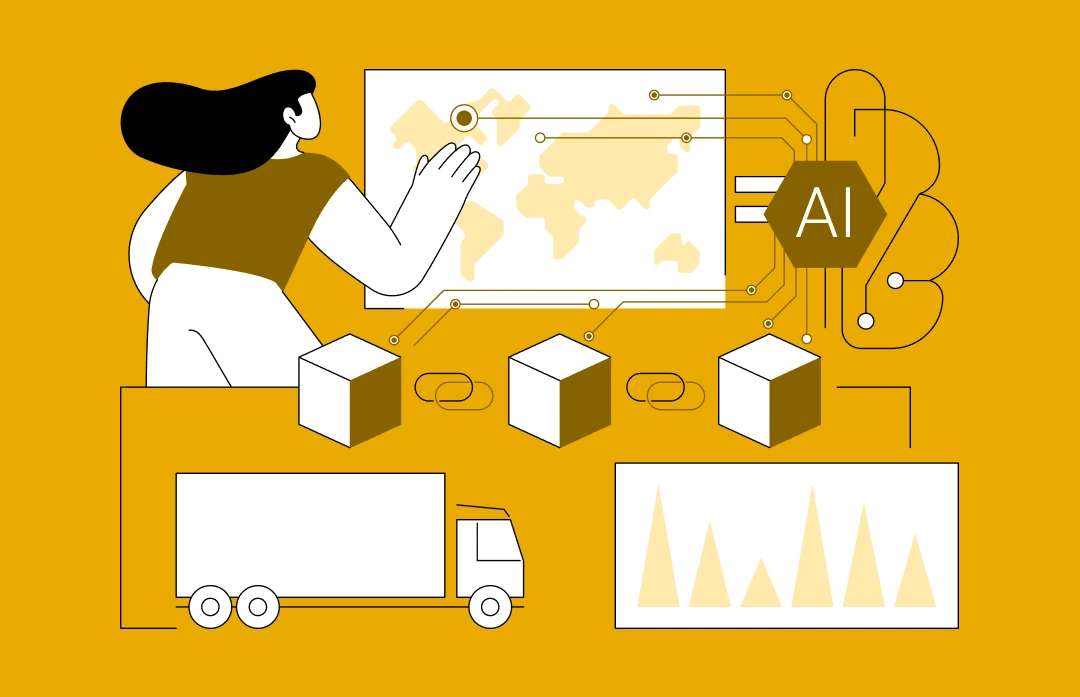
AI in Warehouse Management: Benefits, Use Cases, and Real World Examples
Key takeaways: AI-Driven Optimization: AI enhances warehouse efficiency by automating workflows, reducing errors, and optimizing inventory with real-time data. Cost Reduction: AI cuts operational costs by minimizing labor, storage, and return expenses, with McKinsey noting 5-20% logistics cost savings. Improved Forecasting: AI-powered demand forecasting prevents stockouts and overstocking, improving customer satisfaction and cash flow. Space…

How to Use AI in Personalized Treatment Plans for Diseases?
Key takeaways: AI enables precise, individualized treatment plans by analyzing patient data, genomic profiles, and clinical histories, moving away from generalized protocols. AI models help anticipate medical events and tailor care, improving outcomes through proactive, personalized interventions. AI integrates diverse data sources (EHRs, genetics, imaging) to provide faster, more accurate decision-making in clinical workflows. AI…

